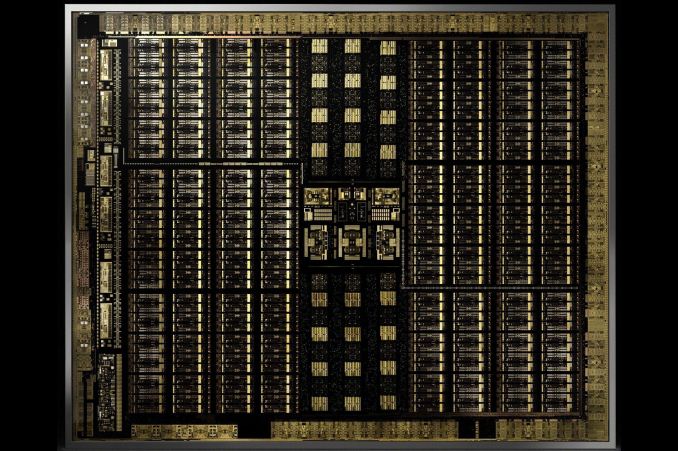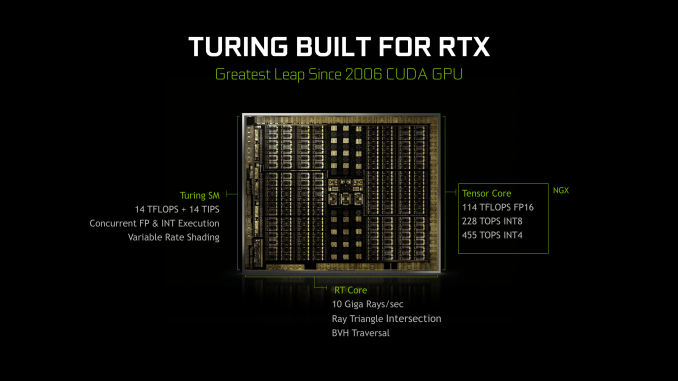The NVIDIA Turing GPU Architecture Deep Dive: Prelude to GeForce RTX
by Nate Oh on September 14, 2018 12:30 PM EST
It’s been roughly a month since NVIDIA's Turing architecture was revealed, and if the GeForce RTX 20-series announcement a few weeks ago has clued us in on anything, is that real time raytracing was important enough for NVIDIA to drop “GeForce GTX” for “GeForce RTX” and completely change the tenor of how they talk about gaming video cards. Since then, it’s become clear that Turing and the GeForce RTX 20-series have a lot of moving parts: RT Cores, real time raytracing, Tensor Cores, AI features (i.e. DLSS), raytracing APIs. All of it coming together for a future direction of both game development and GeForce cards.
In a significant departure from past launches, NVIDIA has broken up the embargos around the unveiling of their latest cards into two parts: architecture and performance. For the first part, today NVIDIA has finally lifted the veil on much of the Turing architecture details, and there are many. So many that there are some interesting aspects that have yet to be explained, and some that we’ll need to dig into alongside objective data. But it also gives us an opportunity to pick apart the namesake of GeForce RTX: raytracing.
While we can't discuss real-world performance until next week, for real time ray tracing it is almost a moot point. In short, there's no software to use with it right now. Accessing Turing's ray tracing features requires using the DirectX Raytracing (DXR) API, NVIDIA's OptiX engine, or the unreleased Vulkan ray tracing extensions. For use in video games, it essentially narrows down to just DXR, which has yet to be released to end-users.
The timing, however, is better than it seems. A year or so later could mean facing products that are competitive in traditional rasterization. And given NVIDIA's traditionally strong ecosystem with developers and middleware (e.g. GameWorks), they would want to leverage high-profile games for ringing up consumer support for hybrid rendering, which is where both ray tracing and rasterization is used.
So as we've said before, with hybrid rendering, NVIDIA is gunning for nothing less than a complete paradigm shift in consumer graphics and gaming GPUs. And insofar as real time ray tracing is the 'holy grail' of computer graphics, NVIDIA has plenty of other potential motivations beyond graphical purism. Like all high-performance silicon design firms, NVIDIA is feeling the pressure of the slow death of Moore's Law, of which fixed function but versatile hardware provides a solution. And where NVIDIA compares the Turing 20-series to the Pascal 10-series, Turing has much more in common with Volta, being in the same generational compute family (sm_75 and sm_70), an interesting development as both NVIDIA and AMD have stated that GPU architecture will soon diverge into separate designs for gaming and compute. Not to mention that making a new standard out of hybrid rendering would hamper competitors from either catching up or joining the market.
But real time ray tracing being what it is, it was always a matter of time before it became feasible, either through NVIDIA or another company. DXR, for its part, doesn't specify the implementations for running its hardware accelerated layer. What adds to the complexity is the branding and marketing of the Turing-related GeForce RTX ecosystem, as well as the inclusion of Tensor Core accelerated features that are not inherently part of hybrid rendering, but is part of a GPU architecture that has now made its way to consumer GeForce.
For the time being though, the GeForce RTX cards are not released yet, and we can’t talk about any real-world data. Nevertheless, the context of hybrid rendering and real time ray tracing is central to Turing and to GeForce RTX, and it will remain so as DXR is eventually released and consumer-relevant testing methodology is established for it. In light of these factors, as well as Turing information we’ve yet to fully analyze, today we’ll focus on the Turing architecture and how it relates to real-time raytracing. And be sure to stay tuned for the performance review next week!












111 Comments
View All Comments
Spunjji - Monday, September 17, 2018 - link
There's no such thing as a bad product, just bad pricing. AMD aren't out of the game but they are playing in an entirely different league.siberian3 - Friday, September 14, 2018 - link
Good architectural leap for nvidia but it is sad very few of gamers can afford the new cards.And AMD is not doing anything for 2018 and probably navi will be mid range on 7nm
V900 - Friday, September 14, 2018 - link
Meh, it’s always been that way with the newest, fastest GPUs.Wait 6 months to a year, and prices will be where people with more modest budgets can play along.
B3an - Friday, September 14, 2018 - link
You must literally live under a rock while also being absurdly naive.It's never been this way in the 20 years that i've been following GPUs. These new RTX GPUs are ridiculously expensive, way more than ever, and the prices will not be changing much at all when there's literally zero competition. The GPU space right now is worse than it's ever been before in history.
Amandtec - Friday, September 14, 2018 - link
I read somewhere that8800GTX + inflation = 2080ti price
Without factoring in inflation the prices seem unprecedented.
Yojimbo - Saturday, September 15, 2018 - link
And you must factor in inflation, otherwise you are just pushing numbers around.Yojimbo - Saturday, September 15, 2018 - link
And comparing the 2080 Ti to previous flagship launch cards is not really proper. The 2080 Ti is a different tier of card. The die size is so much larger than any previous launch GPU. It's just a demonstration of the increase in the amount of resources people are willing to devote to their GPUs, not an indication of an inflation of GPU prices.eddman - Saturday, September 15, 2018 - link
2006 $600 at 2018 dollar value = $750Samus - Saturday, September 15, 2018 - link
What inflation, exactly are you talking about. The dollar hasn't had a substantial change in valuation for 20 years (compared to other first-world currency.)The USD inflation rate has averaged around 2.7%/year since 2000. That means one dollar in 2000 is now worth slightly less than $1.50 today. That means the top-of-the-line GPU released in 2000, I'd take a guess it was the Geforce2 GTS and/or the 3Dfx Voodoo5 5500, both cost $300.
For those who want to throw in cards like the Geforce 2 Ultra and the Voodoo5 6000, the former a card for nVidia to 'probe' the market for how much they could milk it going forward (and creating the situation we have today) and the other a card that never actually "launched"...we can include them for fun. The Ultra launched at $500 (even though it was slower than the Geforce 3 that launched 3 months later) and the Voodoo5 6000 had an MSRP set by 3Dfx at $500.
These were the most expensive gaming-focused GPU's ever made up until that date. Even SLI setups didn't cost $500 (the most expensive Voodoo2 card in the 90's was from Creative Labs @$229/ea - you needed two cards of course - so $460.)
Ok, so you have the absolute cream-of-the-crop cards in 2000 at $500, one was a marketing stunt, and the other never launched because nobody would have bought it. Realistically the most expensive cards were $300. But we will go with $500.
The most expensive high-end gaming focused cards now are $1000+
That would assume an inflation rate of over 5% annually, or the value of the dollar DOUBLING over 2 decades. Which it didn't come close to doing.
Stop using inflation as an excuse. It's bullshit. These companies are fucking greedy. Especially nVidia. They are effectively charging FOUR TIMES more than they used to for the same market segment card. 20 years ago you would have bought a TNT2 Ultra for $230 bucks and had the ultimate card available. Most people purchased entirely capable mainstream cards for $100-$150 like the TNT2 Pro or the Geforce2 MX400 that ran the most demanding games of the day like Counter Strike and Half-Life at 1024x768 in maximum detail.
http://www.in2013dollars.com/2000-dollars-in-2018?...
Yojimbo - Saturday, September 15, 2018 - link
"What inflation, exactly are you talking about."CPI. Consumer Price Index. Even though inflation has been low for quite a while, $649 in 2013 is $697 today. That's almost $50 more, and it's enough to make up the difference between the 2013 launch price of the GTX 780 and the 2018 launch price of the RTX 2080.
I'm not sure why you are talking about cards from 20+ years ago. It's not relevant to my reply. In any case, those cards were completely different. The die sizes were much smaller and the cards were much less capable. They did a lot less of the work, as much of it was done on the CPU. The CPU was much more important to the game performance than today, as was the RAM and other components that were worth spending money on to significantly improve the gaming performance/experience.
"Stop using inflation as an excuse."
I'm not using inflation as an excuse. I'm using inflation as a tool to accurately compare the prices of cards from different years. And doing so clearly shows that the claim that the OP made is wrong. My reply had nothing to do with whether cards were in general cheaper 20 years ago or not. It was in response to "These new RTX GPUs are ridiculously expensive, way more than ever". That's provably untrue. Why are you replying to me and arguing about some entirely different point I wasn't ever talking about?